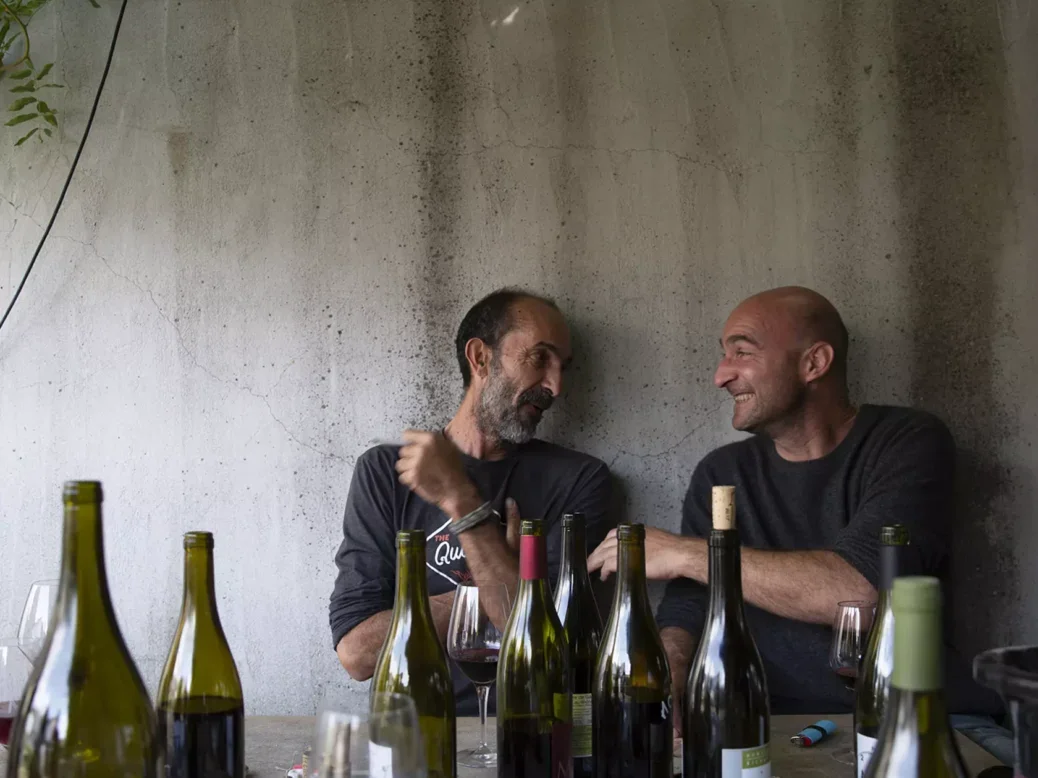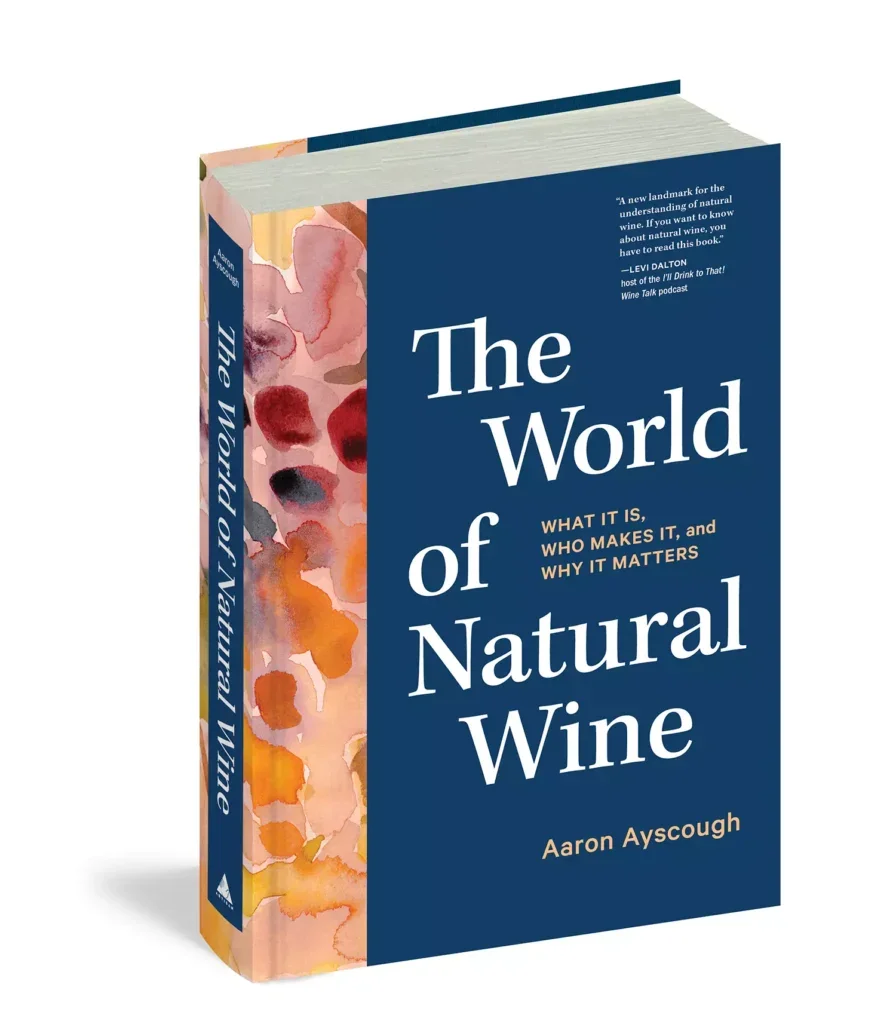
Raymond Blake reviews The World of Natural Wine: What It Is, Who Makes It and Why It Matters by Aaron Ayscough.
How to define “natural”? How indeed. Without even considering wine, the word comes with its own cozy, feel-good baggage. It sits in the opposite corner to “artificial,” and no prizes for guessing which is in the naughty corner. In common parlance, “natural” is a “good” word that can be used to express notions of purity and approbation. It is used to describe something unadulterated, un-messed with. Without overly thinking about it, we bandy it around; we know what it means… until asked to clarify, that is. The Oxford English Dictionary provides some help: “Existing in, or formed by, nature; consisting of objects of this kind; not artificially made, formed, or constructed.” Merriam-Webster is more concise: “Existing in or produced by nature: not artificial.” Hmm…
When applied to wine, “natural” resists definition, for it hardly needs pointing out that wine does not exist in, nor is it produced by, nature. It is man-made. Does that make it artificial or unnatural? This might seem like pedantic hairsplitting, but for some years now, I have harbored a growing belief that, regardless of whether it is their intention or not, proponents’ use of “natural” plays on consumers’ trust of the word. Hence, using “natural” to define or describe a subset of wines has led to confusion and a fog of misunderstanding.
This then fostered a debate that quickly became adversarial (see Francis Percival, “Natural Wine as Culture War,” WFW 36, pp.90–93). Advocates and doubters morphed into proponents and opponents; positions became polarized, leaving common sense and common ground to disappear into a conversational sinkhole between them. Point scoring was the order of the day. The stage was set for either a complete breakdown of communication between those holding different points of view or the publication of a book such as this.
In short, Aaron Ayscough has done an impressive job of researching and collating a vast body of knowledge and information over a period of seven years and synthesizing it into this book. It will hopefully cool the debate and allow for more reasoned arguments, closing the chasm between opposing points of view and getting rid of knee-jerk pronouncements designed to establish a position rather than foster understanding. It runs to over 400 pages, comprising three parts: “What’s Natural,” “A Pantheon of Natural Wine,” and “Enjoying Natural Wine.”
Enlightening but no pat answers
Part I opens with a question: “Natural wine is at once a beverage and a culture. Efforts to define it in narrower terms, as simply a beverage, have so far been frustrated by the nonparticipation of the actors within natural wine culture, chiefly the natural winemakers themselves. Why?” Only a few lines later, what might be considered a dodge-the-question answer is suggested: “Few vignerons wish to adhere to a one-size-fits-all, internationalized rulebook for natural winemaking. Most are content with a definition along the lines of Supreme Court justice Potter Stewart’s famous description of obscenity: ‘I’ll know it when I see it.’”
The whole of this book might be seen as an attempt to define natural wine, though readers seeking an unequivocal definition might come away disappointed. The first paragraph from the opening chapter must suffice: “Natural wine is wine with nothing to hide. Organically farmed grapes, fermented, aged, and bottled without the use of additives, filtration, or transformative corrective procedures. It’s wine that maintains its traditional—and crucial—link to nature. This sets it apart from most wine on the market today, which has been stripped of its origins by intensive agriculture and invasive winemaking.” Thus, there is (unsurprisingly) no pat answer to the “What is natural wine?” question, something glib to be trotted out at a table quiz, for instance. That is not to say, however, that readers won’t be enlightened by the contents of this volume—they will, and in generous measure, too.
Part II makes up the bulk of the book and, although labeled “A Pantheon,” it is heavily Francocentric, almost exclusively comprised of a vinous Tour de France that starts in Beaujolais and finishes, a dozen regions later, in Champagne. The Burgundy chapter is dominated by one name: Philippe Pacalet. He is the sort of ambassador natural wine needs, because not only can he talk the talk, his wines also walk the walk. A whole page is devoted to quotations from Pacalet, which reminded me of a visit I made to his cellars in Beaune just before Covid. Barely had pleasantries been exchanged than he was laying out his stall: “I want to be free from finance to make the wine the way I want. We are making wine, not money.” Pithy asides accompanied each wine tasted. A rather stern Pommard, with tannins in the ascendant, would be fine with age: “Fat will come in the bottle—slowly, like me,” he quipped, patting his belly. A sweet-fruited Clos de Vougeot followed, and then a Ruchottes-Chambertin for which my spoken tasting note was a cryptic “Wow!” “It’s an opera,” Pacalet rejoined. We finished with a “savory and tingling” Puligny-Montrachet, and then it was time to dash off to the next of my visits.

Quite apart from the immediate impression Pacalet’s wines made on palate and mind, a more reflective conclusion saw me wishing for more of the same from other natural winemakers. I wasn’t wishing that they all march to the same beat—far from it; more hoping that they would exercise the same skill and dexterity as Pacalet to produce vividly flavored wines. Quirk for quirk’s sake is not good enough.
I have always found quirk aplenty in the wines of Domaine Prieuré-Roch, founded by the late Henri-Frédéric Roch in 1988 and accorded a full-page entry in this book. Roch, whose family are co-owners of Domaine de la Romanée-Conti, was a memorable character. His wines could soar and dive in quality, and you never knew what you were going to get until you pulled the cork: ethereal flavors that had you ransacking your arsenal of superlatives, or a disappointing feral cacophony. That sort of variation might, just might, be acceptable in humble wines that sell for modest prices, but not for Côte d’Or Burgundies. That is more than a quibble, and it is addressed only obliquely in this book.
Part III comes replete with thought-provoking headings: “How Tasting Has Changed,” “Unlearning Wine,” “The Feeling,” “The Limits of Tasting,” and so on. In short, palate recalibration is needed, and it might also help to abandon all preconceived vinous wisdom while you are at it. While Part II carried conviction and authority, the book tails off in Part III, where home-spun wisdoms are given free rein. Should your wine display an unappealing “mousiness” there is no need to worry: “At the end of the day, encountering mouse in wine is like encountering a mouse in real life—it’s not worth causing a scene about.” Even if you paid top dollar for it? And the page on “How to Store Natural Wine,” while counseling the usual advice about light, heat, and vibration, is robbed of all authority by the photograph captioned: “The carefree organization of Doubs winemaker Georges Comte’s personal cellar.” Here, “carefree” is a euphemism in extremis; the cellar looks like a conflict zone.
Notwithstanding that own goal, photographs are an integral part of this book: There is hardly a page that doesn’t have one, or several. They are of variable quality, but the book would be the lesser without them, for they give compelling visual emphasis to its message. Many are of grizzled, bearded, and tie-less winemakers, a tiny fraction of whom are women, not bearded.
Fostering understanding
In conclusion, I applaud the natural wine movement for its disruptive influence, its forcing people to reconsider old shibboleths, and its shaking up of lazy practices; but I don’t like the holier-than-thou whiff of sanctimony attached to it. The suggestion in this book, implicit rather than overt, is that all wine should be made like this, perhaps even could be made like this. That will never happen: Commercial reality will come calling. Notwithstanding that, as a reaction against the drab homogeneity of industrially produced wines, the natural wine movement deserves high praise. And regardless of your standpoint, this book delivers a stimulating and informative read. It is a fine production, not funky or feral in any respect, and nothing can detract from the huge effort that has gone into it.
It is now half-a-century since glam rock, headlined by timeless talents such as David Bowie and Marc Bolan, burst onto the scene. In their slipstream came dubious successors, more noted for display than content, eye-catching rather than ear-pleasing. Glam rock quickly descended into self-parody, thus opening the door to punk, which roared onstage in reaction to the vacuous, style-over-substance posturing. It was divisive and polarizing—to describe it as “not everyone’s cup of tea” is far too prim.
Natural wines are “not everyone’s cup of tea” either, yet this book will do much to foster understanding, if not affection. In time, it will come to be regarded as the natural wine bible, a compendium of facts, information, and advice delivered in a tone that is generally measured, not polemical. If you cannot fathom why natural wine believers are so messianic, read this book.
The World of Natural Wine: What It Is, Who Makes It and Why It Matters
Aaron Ayscough
Published by Artisan
440 pages; hardback $40 / £31.99






